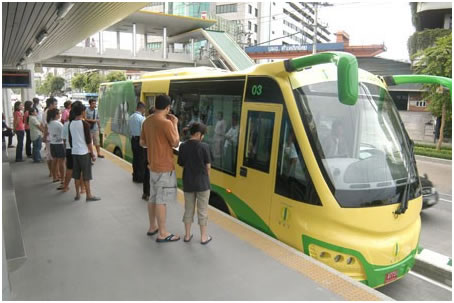Yesterday, I detailed some advantages of bus-rapid transit (BRT) over the much more pricey streetcar and light-rail options that the Greater Greater Washington blog plugs very aggressively (yesterday’s example here) but now appear to be going nowhere.
So what is the barrier to BRT gaining more traction?
Paying Far More for Image Not Substance
Josh Barro on The Upshot blog at the New York Times put his finger on the source of the problem:
“Bus-based public transit in the United States suffers from an image problem.”
That fact, laid out in a 2009 report from the Federal Transit Administration, isn’t surprising, but it has led to a perverse outcome: Transit agencies are spending millions of dollars on new rail infrastructure that is no faster than existing bus service, simply because riders perceive a train as better than a bus.
Barro details how New York is now planning to spend $1 billion on an AirTrain from LaGuardia Airport that will go no faster than the existing bus connections. He reports similar investments in streetcars and trains elsewhere that go no or little faster than existing bus routes.
Corporate Welfare
In Washington, the proposed streetcar slows down far more people on buses than will ride the streetcar. This isn’t “greater” but grandiose public policy that wastes billions of transit dollars.
Indeed, it’s really corporate welfare masked as social justice as it benefits property developers. There is nothing wrong with benefiting developers or other companies if we think that makes good transit policy and economic sense. But it just becomes corporate welfare when we can get the benefits much more cheaply through another similar technology.
Improving BRT’s Image
The good news is that FTA has found that gaining acceptance for lower cost BRT occurs with the adoption of straightforward design and marketing solutions:
That 2009 transit report gives reason to believe it’s possible. The researchers conducted focus groups with “choice riders” in Los Angeles: people who have cars but sometimes use transit. These riders had an unsurprising preference for trains.
“Riding the bus carries a ‘shame factor,’ ” the researchers found. “Most of the choice riders would not consider using it, or if they did, they would feel ashamed and keep it a secret.”
But what the local transit agency marketed as the “Orange Line” — really just a bus route in the San Fernando Valley with high frequencies on a dedicated right of way — managed to gain acceptance among “choice riders.”
As it turns out, making buses look as good as light rail or streetcars is just not that hard as this photo from the Montgomery Planning website shows:
We can even make them look like streetcars, complete with hard and uncomfortable benches, as the former Bethesda Circulator bus (shown at top) demonstrated for many years. People still ride it even though it now looks like a bright red bus.
These design features and marketing simply have to be far less expensive than the literally billions of dollars more that streetcars and light-rail cost to do the same thing. The good news is that BRT is expanding around the country and so hopefully the unfamiliarity with it will decrease.
Conclusion
Public officials along with transit advocates need to get past the idea that trains are better and more elite or equivalent to faster, heavy rail Metro. They’re not. They just waste dollars that could used be to provide more public transit or something else useful. The sooner they realize it, the sooner we might stop spinning our wheels and build something useful and affordable.


